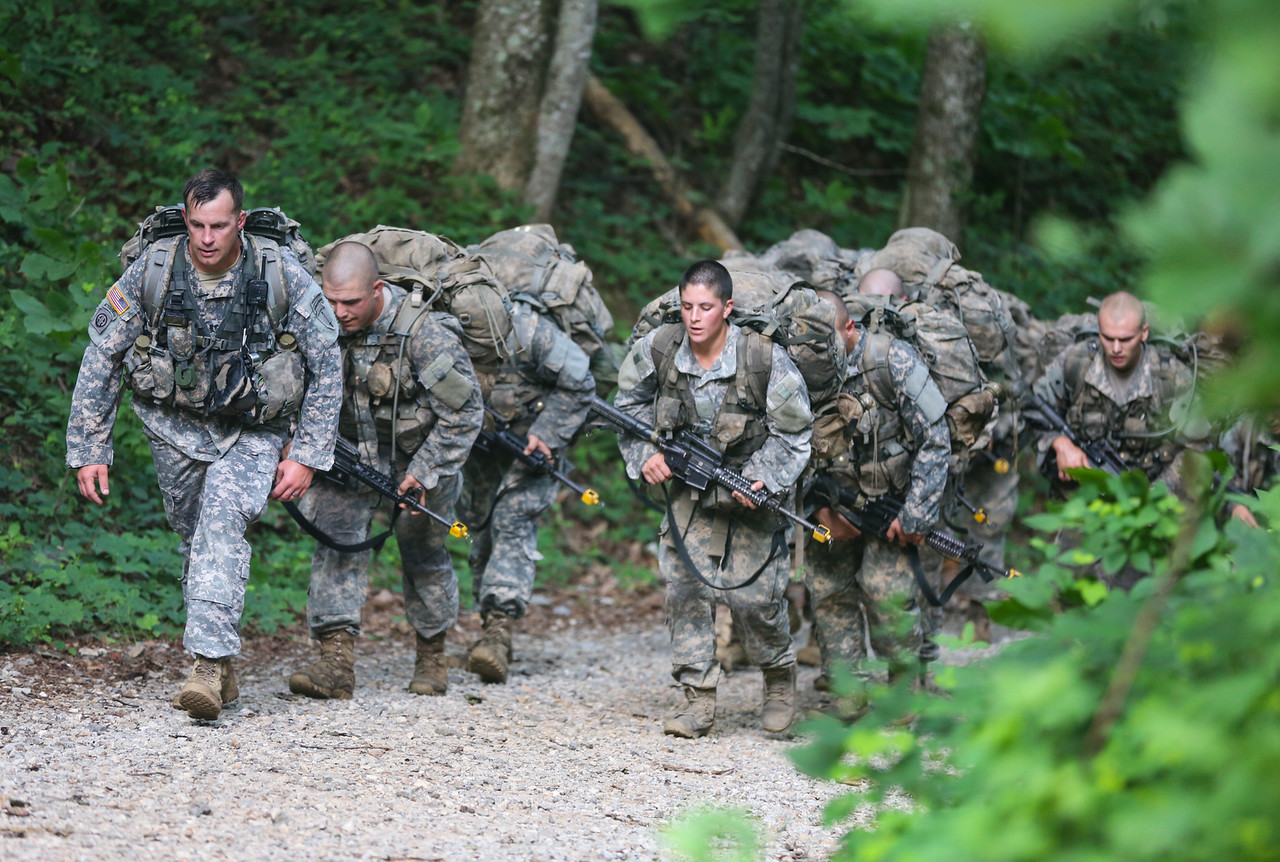
If national security leaders truly want the nation’s best to serve the common defense, they should equally value the unique contributions of all who are willing and able to serve.
One century ago, a massive conflict was mercifully drawing to a close. The First World War subsumed industrialized Europe within a hopeless quagmire of murderous indecision, imprinting an enduring impression onto even its late-arriving American participants. This story of great powers and their contest for dominance offers powerful warnings about the costs to societies that invoke strength, masculine pride, and paternal dominion to justify conflict and to compel their citizens into service. While the idealization of masculinity remains pervasive, the utility of such hierarchies is waning socially, politically, and even on the battlefield.
Yet our armed services – especially those focused on ground combat – continue to struggle with discrimination in the ranks that arises from profound and damaging assumptions about what is and is not necessary in an effective combatant. They are stumbling over the same shifting standards Social historian Ilana Bet-El observed in her study of World War I Britain. The American military establishment continues to produce numerous asymmetrical power relationships where any perceived lack of maleness invites suspicion; hypocritically, women may also be penalized if perceived as too masculine. Lieutenant Colonel Kate Germano, former head of the lone female recruit training battalion in the Marine Corps’ segregated boot camp, was dismissed from her command because she pushed her recruits to defy low expectations – which they did. Afterwards, Lt. Col. Germano published Fight Like a Girl: The Truth About How Female Marines Are Trained (2018), describing the Marine Corps’ pattern of inculcating the inferiority of women into all recruits. The resulting self-fulfilling performance expectations saw decades of women deliberately trained to lower standards in order to produce Marines who were not believed to be competitive with their male counterparts and who – as a result of their deficient training and service culture – could rarely become so. This is not the progress we need.
In order to maintain the strong strategic position of the United States amidst sustained asymmetric conflicts, electronic and esoteric espionage, and fluid international competition, the nation must find a new and more inclusive martial ideal.
Are Volunteers Manlier than Conscripts?
Malleable notions of masculinity, service, and citizenship have informed the majority of organized conflict throughout history, but their exact relationship within a given military structure depends on societal, cultural, and contextual factors. Ilana R. Bet-El studied how First World War-era British leaders influenced their nation’s conceptualization of citizenship in order to supply their war effort with a sufficient number of volunteers. Bet-El describes how recruiters used posters adorned with slogans like “Daddy, What Did You Do in the War?” and “Make Us as Proud of You as We Are of Him!” that idolized the individual soldier and equated voluntary service with the full attainment of masculine maturity. In contrast, involuntary conscripts were perceived to have fallen short of fully achieving this civic adulthood. Volunteering conferred status because being conscripted signaled masculine deficiency – the draftee unable to control his own fate while the volunteer willingly intervened to champion the state’s cause. Those who could avoid being conscripted because of their social or economic status were compelled to volunteer anyway to guarantee their standing in the hierarchy.
Recruiting materials equated voluntary soldiering with masculine adulthood, a status that already carried its own burdens such as supporting a family and the discriminate administration of personal affairs. Thus interwoven with military service, masculinity became an almost unattainable ideal. Striving and hopeful individuals could purchase this idealized status by making the choices encouraged by society (i.e., by volunteering for military service and raising a family), but each payment into this annuity of masculine virtue yielded diminishing returns as each, in turn, came with its own obligations and expectations.
Forgetting a Century of Lessons Learned
Women of the First World War era also felt the dual pressures of state coercion and social stigmatization. Wartime governments sought to mobilize unmarried women to serve in auxiliary support roles but expressly forbid them from engaging in—or even training for—direct combat duties. Female service was carefully controlled because it was seen to pose the double threat of undermining both home-front social norms and the appeal to masculinity utilized by recruiters and officers. When women – or gender-nonconforming men – demonstrate competence in military matters, it exposes the false determinism underlying discriminatory policies. Jennifer Keene, a historian of the First World War, writes that the soldiers in the United States’ own conscription-based army of one hundred years ago felt their involuntary service fulfilled “a social compact between the state” and themselves. Valiant efforts of women suffragists at home and black troops on the battlefields of France sought to extend this link between honorable military service and the full rights of citizenship to include, however reluctantly and incompletely, their own contributions to the war effort.
The resulting tension – as perceptions of concluded civic obligation pulled against systems of control and hierarchy – has colored both the intellectual debates and practical realities of military integration in the ten decades since. Across the twentieth century, the American military has fought to limit the ability of women – and citizens of color – to participate equally within the armed forces, while continuing to embrace their service when it could be fit within accepted social norms. The United States’ Second World War military machine positioned women in subservient roles but needed them to function. The move to an all-volunteer force following the Vietnam War saw military policymakers erasing many restrictions to meet force requirements.
As military service by women becomes more prevalent, it will continue to further erode military hierarchies based on masculine idealization. Ongoing legal challenges to women’s exemption from registration for selective service demonstrate the continued weakening of this distinction. (Note that current selective service regulations require all males, regardless of their gender identity, to register.)
A hundred years ago, nations challenged their citizens to voluntarily commit state violence in order to prove their manliness and loyalty
Those in positions of extreme power frequently pursue their goals by commoditizing youth and vitality through a currency of patriarchal approval. Older men persuade or compel younger men to prove themselves, with the result that men are both the perpetrators and victims of the great majority of non-sexual violence. Furthermore, men enticed into military service expose themselves not only to the hazards of the battlefield but to a greater potential for sexual assault observed when large bodies of troops are concentrated in close proximity.
A hundred years ago, nations challenged their citizens to voluntarily commit state violence in order to prove their manliness and loyalty; presently, the United States continues to offer the same invitation. Veterans who feel they’ve attained this martial ideal are invariably disappointed if society fails to render continuing deference to their achieved status, and this resentment often catalyzes destructive social unrest. American veterans who survived of the horrific battles of the First World War and then suffered the Great Depressions’s economic assaults formed a “Bonus Army” to demand the early payment of promised benefits; instead, federal troops torched their encampment.
Some of today’s dissatisfied veterans, unable to realize perceived promises of membership within a privileged military class, are instead joining white nationalist movements that actively recruit in the U.S. military, and seek to impose brutally regressive racial and sexual hierarchies. Meanwhile, even as recruiters bemoan the number of applicants “infatuated with killing,” they continue to quietly sow last century’s seeds of patriarchal indenture, hoping to reap an ample harvest of recruits willing to endure violence as a means of gaining the requisite status to commit violence themselves.
In the absence of a visible external foe and without deliberate interruption and redirection, those who survive such violence often reproduce their trauma domestically to sustain their performative accretion of relative status and power. Particularly in the aggressively-motivated Marine Corps, this consistently translates into noticeably higher rates of domestic violence and sexual assault.
Grunts are Manly, Personnel Other than Grunts Fight Like Girls
The military environment is uniquely ensconced in rival hierarchies of authority and ethics, and applying a gendered lens helps us to uncover and analyze these as well. The most obvious hierarchy is that of rank, and the bright line dividing officers and enlisted personnel. But the more recent distinction in service culture between combat-oriented “grunts” and “personnel other than grunts” (POGs) is also perfectly suited to gendered analysis. As with the relationship between male and female or between officer and enlisted, what appears to be a simple binary — grunts fight and POGs support—is anything but. Today’s combat veterans in particular frequently describe their relationships in terms of multiple stratified layers of respect. “Terminal Lance” Corporal Maximillian Uriarte perhaps unintentionally alludes to troops’ ubiquitous gendering of these relationships when concluding his description of these “entirely different cultures” by quipping that the least prestigious POGs “have a small penis.”
During my own experiences as an enlisted Marine, I observed firsthand a complex hierarchy that placed infantry personnel at the top, followed closely by other combat arms like artillery and tanks; POG support roles within ground combat units were held in the same general esteem as the direct combat roles within the air wing; somewhere at the bottom were office billets in administrative units. Hazing, nepotism, and disciplinary inconsistencies negatively emphasizing these differences – along axes of background, training, and experience – work to distance service members from one another and their mutual mission in a process that undermines morale and fractures unit cohesion. Additionally, years of institutional streamlining continue to collide with the demands of prolonged war to place support personnel in provisional infantry roles acting as perimeter security, staffing checkpoints, searching detainees, conducting patrols, or standing by as a quick reaction force.
The ongoing friction between designated combat troops lacking confidence in POGs and eager support staff struggling to earn respect destabilizes the entire system. The Marine Corps in particular faces the challenge of fostering its elite esprit de corps in an increasingly flat tactical environment of politically marooned strategic corporals. Essentially, Marines’ redoubtable elan seems to depend in part upon their juxtaposition against some presumably lesser compatriots from which they seek distinction. Lamentably, many Marines tacitly endorse discrimination directed towards perceived lesser citizens in the belief that the suffering produced will bring such persons closer to the Marines’ own ideal of rugged endurance in the face of pain and trauma.
A Slow Race to Victory
If national security leaders truly want the nation’s best to serve the common defense, they should equally value the unique contributions of all who are willing and able to serve. These leaders must change the culture and foster cooperation, integration, and mutual respect. Appeals based on hierarchical masculinity – such as Secretary Mattis’ recent framing of the infantry as “necessarily macho” – only serve to coddle the modern American military with a facile connection to a past ideal of manliness that was virtually unattainable even in its day. Even in organized sports, resistance to female integration is usually more about preserving perceived male space than maximizing performance or ensuring fair competition.
Women today are proving themselves capable of outperforming men in ultra-endurance race events; surely, our armed services would benefit from the inclusion of such dedication and tenacity. As more Americans gain equal access – whether to basic rights, service under arms, or even competition in fair athletics – American society as a whole is improved. As we proceed into an uncertain future, individuals seeking truer justice through more equitable social integration will doubtlessly continue – through their assimilation and the resulting institutional synergy – to challenge a previous century’s conceptions of the necessary connection between masculinity and military service. Effective, honorable military service requires the best from both men and women.
A single well-placed Russian agent was able to significantly disrupt the American security and political establishment by playing to the assumptions of traditionalists, while we continue to debate the efficacy of gender integration. A hundred years ago, competitive imperialist powers invoked hyper-masculine ideals to compel their citizens into one of history’s most destructive conflicts; today, the overzealous continuation of these ideals still threatens to impair our ability to provide for an equitable and multilateral defense of our nation. Together we can do better, and in the coming century we’ll have to.
Joshua Isbell is a veteran of the U.S. Marine Corps and independent scholar. The views expressed in this article are those of the author and do not necessarily represent those of the U.S. Army War College, U.S. Army, or Department of Defense.
Photo: Soldiers conduct Mountaineering training during the Ranger Course on Mount Yonah in Cleveland, Ga., in 2015. Soldiers attend the Ranger Course to learn additional leadership and small unit technical and tactical skills in a physically and mentally demanding, combat simulated environment.
Photo Credit: U.S. Army photo by Staff Sgt. Scott Brooks, public domain.





Someone please tell me this article is a satire of over-the-top leftist entertainment pieces.
Did I land in the duffleblog?… were are the grownups?
I’m sad to say the author doesn’t seem to have learned much from either his Marine Corps service or his independent scholastic endeavors.
In every profession, success is gained by a combination of natural gifts and hard work. Some fields favor those gifted with brains, while others favor those with physical strength. Ground combat remains a masculine profession because biology so strongly advantages men in physical strength.
Willpower can compensate a bit, particularly when the need is temporary, but it has its limits. Furthermore, volunteers are much more likely to sustain their motivation than draftees, so the military likely has a preference.
Lastly, but most importantly, is the reality of wastage. In intense training and real-life operations, underperforming personnel waste resources that could have been better spent elsewhere. The waste can be in monetary terms, but it can also be in time and manpower. It is not in the nation’s interests to let marginal candidates waste resources in the name of “equality”.
Hi James,
Since, as you say, “[in] every profession, success is gained by a combination of natural gifts and hard work,” I’ve resorted to using my gifts of insight and judgement to work for multiple months writing, reviewing, and sourcing this article.
Maybe you could provide, say, just one external source, or maybe a single unit of datum, in your criticism of my position?
How about literally any single anecdote of how “biology so strongly advantages men in physical strength” in a way that *matters* in a modern battlespace of cyberwar, IEDs, drones, etc.?
Ultimately, every person beneath the top performer is “underperforming;” I guess let’s give all the resources to Bezos since he’s *so clearly proven himself capable* of the best and most efficient management possible.
Why, let’s just return the nation to British rule; the colonial Americas were *so much more efficient* for the British Empire, a much better use than wasting those resources on an underperforming independent nation.
Joshua,
Your article seemed devoted to decrying a condition you observed, with little consideration of how that condition arose and whether changing it was even practical or desirable. I attempted to point out some of these unexplored points. Had you published the same article elsewhere, I would have considered it an essay on gender theory and let it be, but you published it in a military forum so I judged it in view practical realities of warfare.
If you want an outside source on why the military is how it is, try any history book on warfare or military organization. Outside of singular individuals and anecdotal accounts, clear trends run through every successful military from ancient Mesopotamia to the present day.
You are not alone in arguing that something new has has voided millennia of history, but all the others were proven wrong, so I don’t like your chances. H. R. McMaster describes this well in his essay “Discussing the Continuities of War and the Future of Warfare: The Defense Entrepreneurs Forum.” Wars will continue to involve ground combatants in environments where physical strength is a requirement. If you want to ignore that, perhaps remove all references to grunts, infantry, or ground combat from your article.
Pretend you are in a position of authority for the Marine Corps, responsible for manning, training, and equipping the force to peak efficiency. You have to match a physically and mentally varied recruit population with similarly varied military requirements. Putting skinny recruits into the infantry or dumb ones into cyber is going to turn out badly; they won’t perform in action if they even pass the training courses, and if they do manage to struggle through training they will have much shorter careers than better-fit candidates.
Back in the day, the military used gender as a binary selection criteria to fit candidates into roles requiring significant physical performance. It was an imprecise criteria, but still more accurate than ignoring the physical differences between average men and women. Today, we have an opportunity for vastly improved predictive criteria, so that we can and should explain to a recruit that they cannot join the infantry because they are short, slight of build, and lack the hormonal levels to maintain the necessary muscle mass. Discrimination based on predicted performance models might produce results similar to the old discrimination based on gender, but reality is reality.
Last, “single unit of datum” is not a thing, in either English or Latin. Datum is already singular in both languages, including military use, so please get it right.
According to the Journal of Applied Physiology, men on average have 26 pounds more muscle than women, which is to say women on average have 2/3s the strength of the average man. I have seen women at my health spa who could max any PT test I took at Ft. Benning’s infantry school. Assuming the only females who are placed in infantry units are like those (and this I would question), I think they would be assets–but the interpersonal relations between young men and women would become a problem. Check the U.S. Navy’s women on cruises of 12 months or more–reportedly half of those crew members get pregnant and cannot complete the cruise. Also check the result of Israel’s first war with their Arab neighbors in which they did employ women on their front lines. The capture and subsequent treatment of them by their enemies persuaded the IDF to never again use women in a front-line capacity.
My own experience as a rifle platoon leader in Vietnam compels me to answer the question on which in combat with this response: not no, but hell no.
Male Vietnam veterans were normally raised to honor and protect women. I make no excuses or apologies for this attitude because it was the way we were raised, as were our fathers before us. Because of this, if for some mysterious reason women were fighting suddenly next to you, there would be a natural tendency to protect and shield them from enemy fire, thereby increasing the risk to yourself of being hit even more.
If, as it seems by the articles and noise about women in the military, there is a real change in the attitudes and societal norms by women to fight on the front lines, I am still unsure that men would suddenly lose the tendency to protect women in danger. I’m also sure we passed this attitude onto our sons, as well.
Despite all the required classes and intimidation by the military to change, the so-called studies of this and that, and political nonsense that always accompanies this, do you really expect to change attitudes by rules, regulations, and legislation or will you attempt to somehow mandate the values we pass along to our own children?